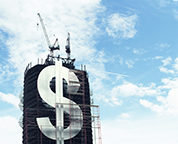New Construction Starts in December Pull Back 16% Nationwide
New construction starts in December retreated 16% to a seasonally adjusted annual rate of $568.2 billion, according to Dodge Data & Analytics.
The decline follows the 13% increase reported for total construction starts in November, when activity reached its highest level in 2014, with the lift coming from several exceptionally large projects. Those included a massive lithium ion battery manufacturing plant, an airport terminal redevelopment program and a liquefied natural gas terminal.
Both nonresidential building and nonbuilding construction in December witnessed substantial percentage declines relative to their robust November amounts. At the same time, residential building managed a modest gain in December with the help of further growth by multifamily housing.
For 2014 as a whole, total construction starts climbed 7% to $575.3 billion. This continues the pattern of moderate expansion for total construction starts reported during the previous two years—2012, up 10%; and 2013, up 9%.
The December statistics produced a reading of 120 for the Dodge Index (2000=100), compared to 143 in November. For all of 2014, the Dodge Index came in at 122, so while December was down considerably from the previous month, it still held close to the average for the full year.
“The construction-start statistics can often be volatile on a month-to-month basis, given the presence of large projects in any one given month,” said Robert A. Murray, chief economist for Dodge Data & Analytics. “The month of November included four projects valued each in excess of $1 billion, while the largest project in December was a $700-million steel mill.
"A better sense of the progression of construction starts over the course of 2014 comes from looking at the data on a quarterly basis. Activity weakened during the first quarter of 2014, falling 10% from the end of 2013, but then showed steady improvement as 2014 proceeded, with gains in the second quarter, up 9%; the third quarter, up 5%; and the fourth quarter, up 2%.,” Murray said.
“The continued expansion for construction starts in 2014 carried several notable features,” Murray added. “The nonresidential building sector showed more growth for commercial building, the first increase for institutional building after five years of decline, and a surge of manufacturing plant projects.
“Residential building was supported by the strengthening multifamily market, but was not able to offer the same upward push as in 2012 and 2013 given the flat performance by single-family housing. Nonbuilding construction showed a slower pace for public works, and while electric utilities lost further momentum, the decline was much less severe than in 2013.
"Looking ahead to 2015, nonresidential building should benefit from more private investment directed at commercial building and more financing for school construction, given the passage of recent bond measures. However, the rate of increase for nonresidential building will be dampened by a slower pace for energy-related manufacturing projects.
“Residential building should see more multifamily housing while renewed growth for single-family housing will need the banking industry to provide potential homebuyers with greater access to home mortgages. Nonbuilding construction will be helped by the fact that federal spending levels for fiscal 2015 were set in December, but Congress needs to address the stopgap federal transportation legislation that expires at the end of May,” Murray said.
Nonresidential Building
Nonresidential building in December fell 23% to $196.6 billion (annual rate), following its 32% increase in the previous month. Manufacturing plant construction plunged 73%, given the comparison to November that included the $2.5-billion lithium ion battery factory for Tesla Motors in Nevada and a $1.3-billion nitrogen urea plant in Oklahoma.
While December did include the start of a $700-million steel mill in Arkansas, the next largest manufacturing projects were valued at $70 million or less. The commercial building group in December slipped 5%, given a steep drop for hotels, down 34%; and much smaller declines for warehouses, down 3%; and offices, down 2%.
The office category did include several noteworthy projects as December starts, such as the $304-million office portion of a $675-million mixed-use project in Miami, a $191-million office complex in Mountain View, Calif., a $150-million office building in Boston, and a $124-million office complex in Seattle. Store construction in December showed improvement after a lackluster November, rising 10%.
The institutional building group in December fell 10%. Much of the decline came as the result of a sharp 71% drop for transportation terminal work, which had been boosted in November by the start of the $1.6-billion airport terminal redevelopment program in Salt Lake City. Educational facilities slipped 4% in December, although the latest month did feature the start of seven high schools valued at $50 million or more, including a $126-million high school in Irvine, Calif.
Health care facilities fell 5% in December, despite the start of a $328-million hospital in the Houston metropolitan area and a $143-million hospital addition in Avon, Ohio.
On the plus side, the public buildings category jumped 62% in December, with the lift coming from a $168-million prison project in San Diego. Also reporting large percentage gains were church construction, up 41%; and amusement-related work, up 40%, with the latter being boosted by the start of a $100-million convention center in Casa Grande, Ariz.
For 2014 as a whole, nonresidential building climbed 17% to $208.2 billion, following the 11% gain that was reported in 2013.
The manufacturing building category surged 74%, lifted by the start of numerous energy-related plants located in the Gulf Coast region of Texas and Louisiana, such as the $3.0-billion Chevron Phillips cracker ethylene plant and the $3.0-billion Exxon petrochemical plant expansion.

